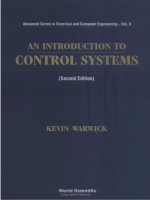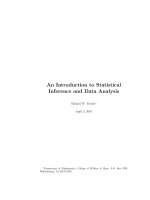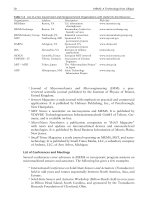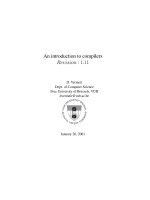- Trang chủ >>
- Khoa Học Tự Nhiên >>
- Vật lý
an introduction to state space time series analysis aug 2007
Bạn đang xem bản rút gọn của tài liệu. Xem và tải ngay bản đầy đủ của tài liệu tại đây (1.05 MB, 189 trang )
An Introduction to State
Space Time Series Analysis
Practical Econometrics
Series Editors
Jurgen Doornik and Bronwyn Hall
Practical econometrics is a series of books designed to provide
accessible and practical introductions to various topics in econo-
metrics. From econometric techniques to econometric modelling
approaches, these short introductions are ideal for applied econo-
mists, graduate students, and researchers looking for a non-technical
discussion on specific topics in econometrics.
An Introduction to State
Space Time Series Analysis
Jacques J. F. Commandeur
Siem Jan Koopman
1
3
Great Clarendon Street, Oxford ox2 6DP
Oxford University Press is a department of the University of Oxford.
It furthers the University’s objective of excellence in research, scholarship,
and education by publishing worldwide in
Oxford New York
Auckland Cape Town Dar es Salaam Hong Kong Karachi
Kuala Lumpur Madrid Melbourne Mexico City Nairobi
New Delhi Shanghai Taipei Toronto
With offices in
Argentina Austria Brazil Chile Czech Republic France Greece
Guatemala Hungary Italy Japan Poland Portugal Singapore
South Korea Switzerland Thailand Turkey Ukraine Vietnam
Oxford is a registered trademark of Oxford University Press
in the UK and in certain other countries
Published in the United States
by Oxford University Press Inc., New York
© Jacques J.F. Commandeur and Siem Jan Koopman 2007
The moral rights of the authors have been asserted
Database right Oxford University Press (maker)
First published 2007
All rights reserved. No part of this publication may be reproduced,
stored in a retrieval system, or transmitted, in any form or by any means,
without the prior permission in writing of Oxford University Press,
or as expressly permitted by law, or under terms agreed with the appropriate
reprographics rights organization. Enquiries concerning reproduction
outside the scope of the above should be sent to the Rights Department,
Oxford University Press, at the address above
You must not circulate this book in any other binding or cover
and you must impose the same condition on any acquirer
British Library Cataloguing in Publication Data
Data available
Library of Congress Cataloging in Publication Data
Data available
Typeset by SPI Publisher Services, Pondicherry, India
Printed in Great Britain
on acid-free paper by
Biddles Ltd., King’s Lynn, Norfolk
ISBN 978–0–19–922887–4
13579108642
Preface
This book provides an introductory treatment of state space methods
applied to unobserved-component time series models which are also
known as structural time series models. The book started as a collection
of personal notes made by JJFC about what he discovered and understood
while studying state space methods for the first time. When colleagues
and friends also found these notes useful and helpful, the idea came up to
make them publicly available. SJK started to cooperate with JJFC on this
book project as part of the highly enjoyable joint projects for the SWOV
Institute for Road Safety Research in Leidschendam, the Netherlands.
Harvey (1989) and Durbin and Koopman (2001) treat the topic of
state space methods at an advanced level suitable for postgraduate and
advanced graduate courses in time series analysis. Elementary time series
books, on the other hand, provide only very limited space to the class
of unobserved-component models. Most of the attention is given to the
Box–Jenkins approach to time series analysis.
The intended audience for this book is practitioners and researchers
working in areas other than statistics, but who use time series on a daily
basis in areas such as the social sciences, quantitative history, biology and
medicine. This book offers a step-by-step approach to the analysis of the
salient features in time series such as the trend, seasonal and irregular
components. Practical problems such as forecasting and missing values
are treated in some detail. The book may also serve as an accompanying
textbook for a basic time series course in econometrics and statistics,
typically at an undergraduate level.
JJFC would like to acknowledge and thank the management and the
colleagues of the SWOV Institute for Road Safety Research for their mental
and financial contribution to this publication. The book is an important
component of the SWOV Research Programme 2003–2006.
Among all SWOV colleagues, JJFC is especially indebted to Frits
Bijleveld, whose never abating and infectious enthusiasm for state space
v
Preface
methods was instrumental in stimulating JJFC to write this book. He
was always willing to answer any questions JJFC had, and is a genius in
exploiting the enormous flexibility that state space methods have to offer.
The authors are grateful to a referee for his positive remarks on an earlier
draft of the book. His many constructive comments have improved the
book considerably. Any mistakes and omissions remain the sole responsi-
bility of the authors.
JJFC also wishes to thank members (some of them, former members)
of the International Co-operation on Time Series Analysis (ICTSA): Peter
Christens, Ruth Bergel, Joanna Zukowska, Filip Van den Bossche, Geert
Wets, Stefan Hoeglinger, Ward Vanlaar, Phillip Gould, Max Cameron,
and Stewart Newstead, for their inspiring contributions to our in-depth
discussions on time series analysis, and for their encouraging response to
earlier drafts of the book.
SJK would like to thank his colleagues at the Department of Economet-
rics, Vrije Universiteit Amsterdam, for giving him the opportunity to work
on this book.
The book was written in L
A
T
E
X using the MiKTeX system
(). We thank Frits Bijleveld for his assistance
in setting up the L
A
T
E
X system. The Ox and SsfPack code for carrying
out the analyses discussed in the book, as well as the data files,
can be downloaded from and from
.
vi
Contents
List of Figures x
List of Tables xiv
1. Introduction 1
2. The local level model 9
2.1. Deterministic level 10
2.2. Stochastic level 15
2.3. The local level model and Norwegian fatalities 18
3. The local linear trend model 21
3.1. Deterministic level and slope 21
3.2. Stochastic level and slope 23
3.3. Stochastic level and deterministic slope 26
3.4. The local linear trend model and Finnish fatalities 28
4. The local level model with seasonal 32
4.1. Deterministic level and seasonal 34
4.2. Stochastic level and seasonal 38
4.3. Stochastic level and deterministic seasonal 42
4.4. The local level and seasonal model and UK inflation 43
5. The local level model with explanatory variable 47
5.1. Deterministic level and explanatory variable 48
5.2. Stochastic level and explanatory variable 52
6. The local level model with intervention variable 55
6.1. Deterministic level and intervention variable 56
6.2. Stochastic level and intervention variable 59
7. The UK seat belt and inflation models 62
7.1. Deterministic level and seasonal 63
7.2. Stochastic level and seasonal 64
7.3. Stochastic level and deterministic seasonal 67
7.4. The UK inflation model 70
vii
Contents
8. General treatment of univariate state space models 73
8.1. State space representation of univariate models
∗
73
8.2. Incorporating regression effects
∗
78
8.3. Confidence intervals 81
8.4. Filtering and prediction 84
8.5. Diagnostic tests 90
8.6. Forecasting 96
8.7. Missing observations 103
9. Multivariate time series analysis
∗
107
9.1. State space representation of multivariate models 107
9.2. Multivariate trend model with regression effects 108
9.3. Common levels and slopes 111
9.4. An illustration of multivariate state space analysis 113
10. State space and Box–Jenkins methods for time series analysis 122
10.1. Stationary processes and related concepts 122
10.1.1. Stationary process 122
10.1.2. Random process 123
10.1.3. Moving average process 125
10.1.4. Autoregressive process 126
10.1.5. Autoregressive moving average process 128
10.2. Non-stationary ARIMA models 129
10.3. Unobserved components and ARIMA 132
10.4. State space versus ARIMA approaches 133
11. State space modelling in practice 135
11.1. The STAMP program and SsfPack 135
11.2. State space representation in SsfPack
∗
136
11.3. Incorporating regression and intervention effects
∗
139
11.4. Estimation of a model in SsfPack
∗
142
11.4.1. Likelihood evaluation using SsfLikEx 144
11.4.2. The score vector 146
11.4.3. Numerical maximisation of likelihood in Ox 149
11.4.4. The EM algorithm 150
11.4.5. Some illustrations in Ox 151
11.5. Prediction, filtering, and smoothing
∗
154
12. Conclusions 157
12.1. Further reading 159
APPENDIX A. UK drivers KSI and petrol price 162
viii
Contents
APPENDIX B. Road traffic fatalities in Norway and Finland 164
APPENDIX C. UK front and rear seat passengers KSI 165
APPENDIX D. UK price changes 167
Bibliography 171
Index 173
ix
List of Figures
1.1. Scatter plot of the log of the number of UK drivers KSI against
time (in months), including regression line. 2
1.2. Log of the number of UK drivers KSI plotted as a time series. 4
1.3. Residuals of classical linear regression of the log of the number
of UK drivers KSI on time. 4
1.4. Correlogram of random time series. 5
1.5. Correlogram of classical regression residuals. 6
2.1. Deterministic level. 13
2.2. Irregular component for deterministic level model. 13
2.3. Stochastic level. 16
2.4. Irregular component for local level model. 17
2.5. Stochastic level for Norwegian fatalities. 18
2.6. Irregular component for Norwegian fatalities. 19
3.1. Trend of stochastic linear trend model. 24
3.2. Slope of stochastic linear trend model. 25
3.3. Irregular component of stochastic linear trend model. 25
3.4. Trend of stochastic level and deterministic slope model. 27
3.5. Trend of deterministic level and stochastic slope model for
Finnish fatalities (top), and stochastic slope component (bottom). 29
3.6. Irregular component for Finnish fatalities. 30
4.1. Log of number of UK drivers KSI with time lines for years. 33
4.2. Combined deterministic level and seasonal. 35
4.3. Deterministic level. 36
4.4. Deterministic seasonal. 36
4.5. Irregular component for deterministic level and seasonal model. 37
4.6. Stochastic level. 39
4.7. Stochastic seasonal. 40
x
List of Figures
4.8. Stochastic seasonal for the year 1969. 40
4.9. Irregular component for stochastic level and seasonal model. 41
4.10. Stochastic level, seasonal and irregular in UK inflation series. 43
5.1. Deterministic level and explanatory variable ‘log petrol price’. 51
5.2. Conventional classical regression representation of
deterministic level and explanatory variable ‘log petrol price’. 51
5.3. Irregular component for deterministic level model with
explanatory variable ‘log petrol price’. 52
5.4. Stochastic level and deterministic explanatory variable ‘log
petrol price’. 53
5.5. Irregular for stochastic level model with deterministic
explanatory variable ‘log petrol price’. 53
6.1. Deterministic level and intervention variable. 57
6.2. Conventional classical regression representation of
deterministic level and intervention variable. 58
6.3. Irregular component for deterministic level model with
intervention variable. 59
6.4. Stochastic level and intervention variable. 60
6.5. Irregular component for stochastic level model with
intervention variable. 60
7.1. Deterministic level plus variables log petrol price and seat belt law. 64
7.2. Stochastic level plus variables log petrol price and seat belt law. 65
7.3. Stochastic seasonal. 66
7.4. Irregular component for stochastic level and seasonal model. 66
7.5. Correlogram of irregular component of completely
deterministic level and seasonal model. 68
7.6. Correlogram of irregular component of stochastic level and
deterministic seasonal model. 69
7.7. Local level (including pulse interventions), local seasonal and
irregular for UK inflation time series data. 71
8.1. Level estimation error variance for stochastic level and
deterministic seasonal model applied to the log of UK drivers KSI. 82
8.2. Stochastic level and its 90% confidence interval for stochastic
level and deterministic seasonal model applied to the log of
UK drivers KSI. 83
xi
List of Figures
8.3. Deterministic seasonal and its 90% confidence interval for
stochastic level and deterministic seasonal model applied to
the log of UK drivers KSI. 83
8.4. Stochastic level plus deterministic seasonal and its 90%
confidence interval for stochastic level and deterministic
seasonal model applied to the log of UK drivers KSI. 84
8.5. Smoothed and filtered state of the local level model applied to
Norwegian road traffic fatalities. 86
8.6. Illustration of computation of the filtered state for the local
level model applied to Norwegian road traffic fatalities. 86
8.7. One-step ahead prediction errors (top) and their variances
(bottom) for the local level model applied to Norwegian road
traffic fatalities. 88
8.8. Standardised one-step prediction errors of model in Section 7.3. 91
8.9. Correlogram of standardised one-step prediction errors in
Figure 8.8, first 10 lags. 92
8.10. Histogram of standardised one-step prediction errors in Figure 8.8. 94
8.11. Standardised smoothed level disturbances (top) and
standardised smoothed observation disturbances (bottom) for
analysis of UK drivers KSI in Section 4.3. 95
8.12. Standardised smoothed level disturbances (top) and
standardised smoothed observation disturbances (bottom) for
analysis of UK drivers KSI in Section 7.3. 97
8.13. Filtered level, and five year forecasts for Norwegian fatalities,
including their 90% confidence interval. 98
8.14. Filtered trend, and five-year forecasts for Finnish fatalities,
including their 90% confidence limits. 99
8.15. Forecasts for t = 170, ,192 including their 90% confidence
interval. 102
8.16. Last four years (1981–1984) in the time series of the log of
numbers of drivers KSI: observed series, forecasts obtained
from the analysis up to February 1983, and modelled
development for the complete series including an
intervention variable for February 1983. 102
8.17. Stochastic level estimation error variance for log drivers KSI
with observations at t =48, ,62 and t = 120, ,140 treated
as missing. 103
xii
List of Figures
8.18. Stochastic level and its 90% confidence interval for log drivers
KSI with observations at t =48, ,62 and t = 120, ,140
treated as missing. 104
8.19. Seasonal estimation error variance for log drivers KSI with
observations missing at t =48, ,62 and t = 120, ,140. 104
8.20. Deterministic seasonal and its 90% confidence interval for
t =25, ,72. 105
8.21. Irregular component. 105
9.1. Log of monthly numbers of front seat passengers (top) and
rear seat passengers (bottom) killed or seriously injured in the
UK in the period 1969–1984. 114
9.2. Level disturbances for rear seat (horizontal) versus front seat
KSI (vertical) in a seemingly unrelated model. 115
9.3. Levels of treatment and control series in the seemingly
unrelated model. 116
9.4. Level of treatment against level of control series in the
seemingly unrelated model. 116
9.5. Level disturbances for rear (horizontal) against front seat KSI
(vertical), rank one model. 118
9.6. Level of treatment against level of control series in rank one model. 118
9.7. Levels of treatment and control series, rank one model. 119
9.8. Level of treatment series plus intervention, and level of
control series, rank one model. 119
9.9. Deterministic seasonal of treatment and control series, rank
one model. 120
10.1. Realisation of a random process. 124
10.2. Correlogram for lags 1 to 12 of data in Figure 10.1. 124
10.3. Example of a random walk with Ï
1
= 0. 125
10.4. Correlogram for lags 1 to 12 of the data in Figure 10.3. 126
10.5. Realisation of a MA(1) process with ‚
0
=1and‚
1
=0.5. 127
10.6. Correlogram for lags 1 to 12 of data in Figure 10.5. 127
10.7. Realisation of an AR(1) process with ·
1
=0.5. 128
10.8. Correlogram for lags 1 to 12 of time series in Figure 10.7. 129
10.9. Realisation of an ARMA(1, 1) process with ·
1
= ‚
1
=0.5. 130
10.10. Correlogram for lags 1 to 12 of data in Figure 10.9. 130
xiii
List of Tables
1.1. Shifting of residuals for computation of autocorrelations. 5
2.1. Diagnostic tests for deterministic level model and log UK drivers KSI. 14
2.2. Diagnostic tests for local level model and log UK drivers KSI. 17
2.3. Diagnostic tests for local level model and log Norwegian fatalities. 19
3.1. Diagnostic tests for deterministic linear trend model and log UK
drivers KSI. 23
3.2. Diagnostic tests for the local linear trend model applied to the
log of the UK drivers KSI. 26
3.3. Diagnostic tests for deterministic level and stochastic slope
model, and log Finnish fatalities. 30
4.1. Diagnostic tests for deterministic level and seasonal model and
log UK drivers KSI. 37
4.2. Diagnostic tests for stochastic level and seasonal model and log
UK drivers KSI. 41
4.3. Diagnostic tests for local level and seasonal model and UK
inflation series. 45
7.1. Diagnostic tests for the deterministic model applied to the UK
drivers KSI series. 64
7.2. Diagnostic tests for the stochastic model applied to the UK
drivers KSI series. 67
7.3. Diagnostic tests for the local level and seasonal model including
pulse intervention variables for the UK inflation series. 72
xiv
1
Introduction
This book introduces time series analysis using state space methodology
to readers who are neither familiar with time series analysis nor with state
space methods. The only background required in order to understand the
material in this book is a basic knowledge of classical linear regression
models, of which a condensed review is provided first. A few sections
also assume familiarity with matrix algebra. These starred sections may
however be skipped without losing the flow of the exposition.
In classical regression analysis a linear relationship is assumed between
a criterion or dependent or endogenous variable y, and a predictor or
independent or exogenous variable x. Deviations from this relationship
are assumed to come from a random process (see Chapter 10 for the defin-
ition of a random process) centred at zero. The standard regression model
for n observations of y (denoted by y
i
for i =1, ,n) and x (denoted by
x
i
for i =1, ,n) is formally written as
y
i
= a + bx
i
+ ε
i
,ε
i
∼ NID(0, Û
2
ε
) (1.1)
for i =1, ,n. The statement
ε
i
∼ NID(0, Û
2
ε
) (1.2)
in (1.1) is shorthand notation for the assumption that the disturbances
or errors or residuals ε
i
are normally and independently distributed with
mean equal to zero and variance equal to Û
2
ε
.
The regression model (1.1) has three unknown coefficients that can
be estimated by least squares methods. In particular, the least squares
estimates of a and b, denoted by ˆa and
ˆ
b, respectively, are calculated by
ˆ
b =
n
i=1
(x
i
− ¯x)y
i
/
n
i=1
(x
i
− ¯x)
2
, ˆa =¯y −
ˆ
b¯x,
1
Introduction
where ¯y and ¯x are the sample means of y
i
and x
i
, respectively, for i =
1, ,n. The least squares estimate of the disturbance variance Û
2
ε
, denoted
by ˆÛ
2
ε
, is calculated by
ˆÛ
2
ε
=
n
i=1
(y
i
− ˆa −
ˆ
bx
i
)
2
/ (n − 2).
More detailed discussions on least squares methods can be found in many
textbooks on statistics and econometrics.
Suppose that the dependent variable y
i
in (1.1) refers to the log of the
monthly number of drivers killed or seriously injured (KSI) in the United
Kingdom (UK) for the period January 1969 to December 1984. Since the
period spans 16 years, we have n =16× 12 = 192 observations and y
i
is
observed for i =1, ,192. This set of observations for y
i
can be referred to
as a time series because it consists of repeated measurements in time of the
same phenomenon. Further, suppose that the independent variable x
i
in
(1.1) is the index of time points in the series, that is x
i
= i =1, 2, ,192.
A scatter plot of variable y on x together with the best fitting line
according to classical linear regression are presented in Figure 1.1. The
0 20 40 60 80 100 120 140 160 180
7.0
7.1
7.2
7.3
7.4
7.5
7.6
7.7
7.8
7.9
log UK drivers KSI against time (in months)
regression line
Figure 1.1. Scatter plot of the log of the number of UK drivers KSI against time (in
months), including regression line.
2
Introduction
equation of the regression line in Figure 1.1 is
ˆy
i
=ˆa +
ˆ
bx
i
=7.5458 − 0.00145 x
i
,
with error variance Û
2
ε
=0.022998. The standard F -test for fit yields
F
(1,190)
=53.775 (p < 0.001), implying that the linear relationship
between the criterion variable y and the predictor variable x is highly
significant. Graphically, the intercept a =7.5458 in model (1.1) is the
point where the regression line intersects with the y-axis, as is confirmed
by inspection of Figure 1.1. Therefore, the intercept determines the level
of the regression line on the y-axis. The value of the regression coefficient
or weight
b = −0.00145 determines the slope of the regression line (i.e. the
tangent of its angle with the x-axis).
Whether this analysis is satisfactory remains to be seen. We have
established that time is a significant predictor of the log of the num-
bers of drivers KSI, and that there is a negative relation between these
two variables: as time proceeds the log of the number of drivers killed
or seriously injured decreases. However, a key assumption of classical
regression analysis is not considered in the analysis. The observations
y, after their correction for the intercept and the exogenous variable x,
are assumed to be independent of each other. This is implied by (1.2). In
the present example these observations are not independent because they
are interrelated through time. This becomes more obvious by connecting
the consecutive observations in Figure 1.1 with lines, as is illustrated in
Figure 1.2. It shows that there is a systematic pattern in the time series y
i
that can only partially be caught by the intercept and the time variable
x
i
= i. The residuals should be randomly distributed. However, Figure 1.3
shows that the residuals are clearly not randomly distributed.
A useful diagnostic tool for investigating the randomness of a set of
observations is the correlogram. The correlogram is a graph containing
correlations between an observed time series and the same time series
shifted k time points into the future. Thus, the correlogram of the least
squares errors ˆÂ
i
= y
i
− ˆa −
ˆ
bx
i
in Figure 1.3 (which is also a time series)
consists of the correlation between ˆÂ
i
and ˆÂ
i−1
, the correlation between
ˆÂ
i
and ˆÂ
i−2
, the correlation between ˆÂ
i
and ˆÂ
i−3
, and so on. Table 1.1
illustrates for some arbitrary numbers how the residuals are shifted in time
in order to compute these correlations.
Using a more general notation, the correlogram contains the correla-
tions between ˆÂ
i
and ˆÂ
i−k
, for k =1, 2, 3, Since k equals the distance
in time between the observations, it is called a lag. Moreover, since the
3
Introduction
0 20 40 60 80 100
120 140
160
180
7.0
7.1
7.2
7.3
7.4
7.5
7.6
7.7
7.8
7.9
log UK drivers KSI
Figure 1.2. Log of the number of UK drivers KSI plotted as a time series.
0
20
40
60
80
100
120
140
160
180
−0.3
−0.2
−0.1
0.0
0.1
0.2
0.3
0.4
residuals
Figure 1.3. Residuals of classical linear regression of the log of the number of UK
drivers KSI on time.
4
Introduction
Table 1.1. Shifting of residuals for
computation of autocorrelations.
k =0123
i ˆÂ
i
ˆÂ
i −k
ˆÂ
i −k
ˆÂ
i −k
10.2———
2 −0.4 0.2 — —
30.0−0.4 0.2 —
4 0.3 0.0 −0.4 0.2
5 −0.2 0.3 0.0 −0.4
60.1−0.2 0.3 0.0
correlations are computed between a variable and itself (albeit shifted in
time), they are called autocorrelations.
The correlogram of an independently distributed series of residuals
is expected to consist of zeroes. In this case, the correlogram typically
takes on the form shown in Figure 1.4. The two horizontal lines in the
correlogram are the 95% confidence limits ±2/
√
n = ±2/
√
192 = ±0.144.
If residuals are randomly distributed then they are independent of one
another. In the correlogram, the independence between random normally
distributed residuals is reflected in the fact that all autocorrelations (of
0
5
10
15
−0.75
−0.50
−0.25
0.00
0.25
0.50
0.75
1.00
ACF−random residuals
Figure 1.4. Correlogram of random time series.
5
Introduction
0
5
10
15
−0.75
−0.50
−0.25
0.00
0.25
0.50
0.75
1.00
ACF−regression residuals
Figure 1.5. Correlogram of classical regression residuals.
which the first 14 are graphed in Figure 1.4) are close to zero, and do not
exceed the confidence limits.
In contrast, the correlogram containing the first 14 autocorrelations of
the classical regression residuals in Figure 1.3 takes on the form presented
in Figure 1.5. The non-random nature of these residuals is confirmed by
the fact that the correlogram in Figure 1.5 contains many autocorrelations
significantly different from zero.
In principle, there is nothing wrong in fitting a classical regression
model on the data in Figure 1.1 to obtain a rough idea of the linear trend
in the series. As soon as standard statistical tests are applied to ascertain
whether or not the relationship should be attributed to chance, however,
various problems arise. As noted above, the F -test (or, equivalently, the
t-test for the regression weight) would lead one to conclude that the
negative relationship between the number of UK drivers KSI and time is
highly significant. These tests are based on the assumption that the errors
are randomly distributed, an assumption that is clearly violated in this
case.
When the first order residual autocorrelation (i.e. the residual autocorre-
lation for lag 1) is positive and significantly different from zero, a positive
residual tends to be followed by one or more other positive residuals, and
6
Introduction
a negative residual tends to be followed by one or more other negative
residuals. As pointed out in the literature (see, e.g., Ostrom, 1990; Belle,
2002), the error variance for standard statistical tests is seriously underes-
timated in this case. This in turn leads to a large overestimation of the F -
or t-ratio, and therefore to overly optimistic conclusions about the linear
relation between the dependent variable and time.
On the other hand, when the first order residual autocorrelation is
negative and significantly deviates from zero, then a positive residual
tends to be followed by a negative residual, and vice versa. In this case the
error variance for the standard statistical test is seriously overestimated,
leading to a large underestimation of the F -ort-ratio. Therefore, overly
pessimistic conclusions about the linear relationship between the crite-
rion variable and time will be drawn.
Time series analysis has the primary task to uncover the dynamic evolu-
tion of observations measured over time. It is assumed that the dynamic
properties cannot be observed directly from the data. The unobserved
dynamic process at time t is referred to as the state of the time series.
The state of a time series may consist of several components, which will
be introduced one by one in the following chapters. First, in Chapters 2,
3, and 4, components are presented that are useful for obtaining an
adequate description of a time series. These components are the level,
the slope and the seasonal. Then, in Chapters 5 and 6, components of
the state are discussed that are helpful in finding explanations for the
underlying development in the series. These components are explanatory
and intervention variables. In Chapter 7 analyses are presented where
descriptive and explanatory components from the previous chapters are
combined into one model.
A third important application of time series analysis is the ability to
predict or forecast (unknown) time series observations in the future. This
aspect of time series analysis is discussed in Chapter 8. This chapter also
presents a general notation for univariate state space models and alterna-
tive ways of dealing with explanatory and intervention variables. Further,
confidence intervals, the filtered state, one-step ahead prediction errors
and their variances, diagnostic tests, and the handling of missing obser-
vations in state space methods are discussed in this chapter. Chapter 9
introduces multivariate analysis of time series data. In Chapter 10 a
very basic introduction to Box–Jenkins ARIMA models is provided, thus
allowing for an evaluation of the relative merits of state space and Box–
Jenkins methods for time series analysis. Finally, Chapter 11 shows how
7
Introduction
to perform all time series analyses discussed in Chapters 1 through 9 in
SsfPack, a set of C routines collected in a library which has been linked to
the
Ox programming language.
Throughout the book, all univariate state space models are applied to
the log of the monthly number of drivers killed or seriously injured (KSI)
in the UK in the period January 1969 to December 1984 (see Figure 1.2).
The actual numbers in this series (not in logs) are given in Appendix A.
This is done even when the model under discussion is clearly not appro-
priate for this time series. In those cases, however, alternative illustrations
are provided for which the model is closer to a correctly specified model.
Moreover, in Chapters 4 and 7 results are presented of the analysis of
quarterly price changes in the UK in the years 1950 through 2001.
Finally, most state space models are presented in their deterministic as
well as in their stochastic form. What we mean by this distinction will
become clear in the following chapters. The purpose of discussing the
results of analyses with deterministic as well as with stochastic state space
models is twofold. First, it shows the great flexibility of state space models
in that both simple and multiple classical regression models are easily
fitted in the framework of state space modelling. Second, it provides a
means to offset the time series models presented in this book against clas-
sical regression analysis, showing the effectiveness of state space methods
when dealing with time series data.
In the next chapter, we start off with a state space model that is even
more simple than classical linear regression. In this model only the inter-
cept of (1.1) is taken into consideration.
8
2
The local level model
A basic example of the state space model is the local level model. In
this model the level component is allowed to vary in time. The level
component can be conceived of as the equivalent of the intercept a
in the classical regression model (1.1). As the intercept determines the
level of the regression line, the level component plays the same role in
state space modelling. The important difference is that the intercept in
a regression model is fixed whereas the level component in a state space
model is allowed to change from time point to time point. In case the level
component does not change over time and is fixed for all time points, the
level component is equivalent to the intercept. In other words, it is then a
global level and applicable for all time points. In case the level component
changes over time, the level component applies locally and therefore the
corresponding model is referred to as the local level model.
The local level model can be formulated as
y
t
= Ï
t
+ ε
t
,ε
t
∼ NID(0, Û
2
ε
)
Ï
t+1
= Ï
t
+ Ó
t
, Ó
t
∼ NID(0, Û
2
Ó
)
(2.1)
for t =1, ,n, where Ï
t
is the unobserved level at time t, ε
t
is the obser-
vation disturbance at time t, and Ó
t
is what is called the level disturbance
at time t. In the literature on state space models, the observation dis-
turbances ε
t
are also referred to as the irregular component. The observa-
tion and level disturbances are all assumed to be serially and mutually
independent and normally distributed with zero mean and variances Û
2
ε
and Û
2
Ó
, respectively. The first equation in (2.1) is called the observation
or measurement equation, while the second equation is called the state
equation. Since the level equation in (2.1) defines a random walk (see
Chapter 10), the local level model is also referred to as the random walk
plus noise model (where the noise refers to the irregular component).
9
The local level model
The second equation in (2.1) is crucial in time series analysis. In the
state equation, time dependencies in the observed time series are dealt
with by letting the state at time t + 1 be a function of the state at time
t. Therefore, it takes into account that the observed value of the series at
time point t + 1 is usually more similar to the observed value of the time
series at time point t than to any other previous value in the series.
When the state disturbances are all fixed on Ó
t
= 0 for t =1, ,n, model
(2.1) reduces to a deterministic model: in this case the level does not vary
over time. On the other hand, when the level is allowed to vary over
time, it is treated as a stochastic process. In Section 2.1 we discuss the
results of the analysis of the log of the number of UK drivers KSI with a
deterministic level. Then in Section 2.2, the latter results are compared
with those obtained with a stochastic level component. As the local level
model is not appropriate for the UK drivers KSI series, the model is also
applied to the annual numbers of road traffic fatalities in Norway in
Section 2.3.
2.1. Deterministic level
If the level disturbances in (2.1) are all fixed on Ó
t
= 0 for t =1, ,n,itis
easily verified that:
for t =1: y
1
= Ï
1
+ ε
1
,
Ï
2
= Ï
1
+ Ó
1
= Ï
1
+0=Ï
1
for t =2: y
2
= Ï
2
+ ε
2
= Ï
1
+ ε
2
,
Ï
3
= Ï
2
+ Ó
2
= Ï
2
+0=Ï
1
for t =3: y
3
= Ï
3
+ ε
3
= Ï
1
+ ε
3
,
Ï
4
= Ï
3
+ Ó
3
= Ï
3
+0=Ï
1
and so on.
Summarising, in this case the local level model (2.1) simplifies to
y
t
= Ï
1
+ ε
t
,ε
t
∼ NID(0, Û
2
ε
) (2.2)
for t =1, ,n. Therefore, in this special situation everything relies on
the value of Ï
1
, the value of the level at time t = 1. Once this value is
established, it remains constant for all other time points t =2, ,n.
10









